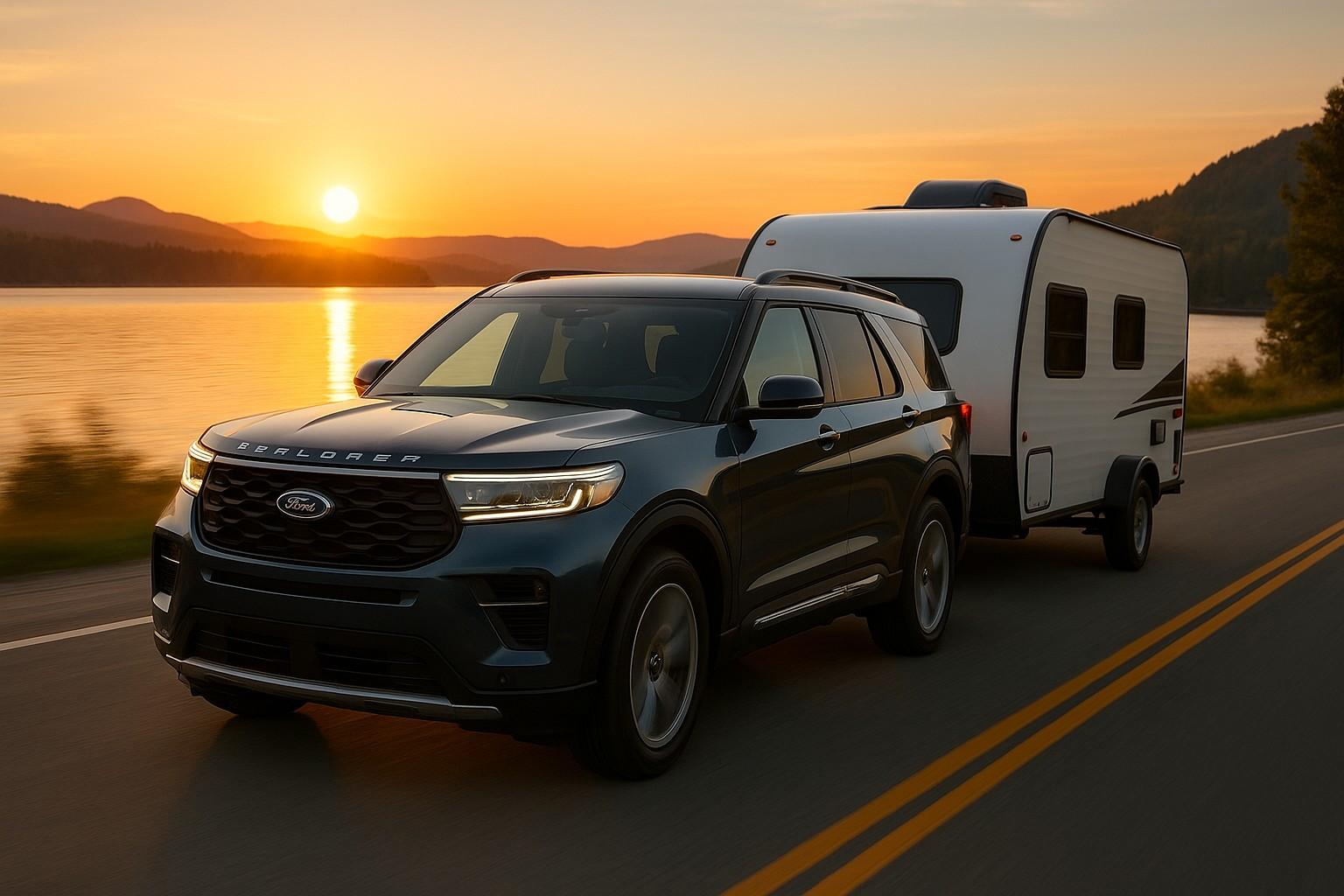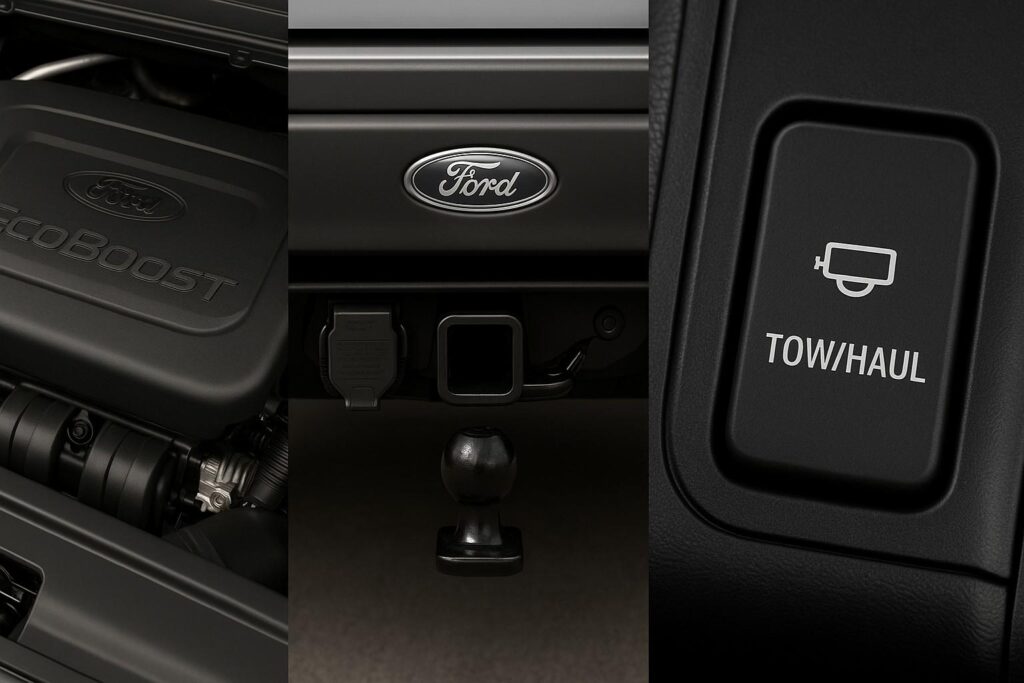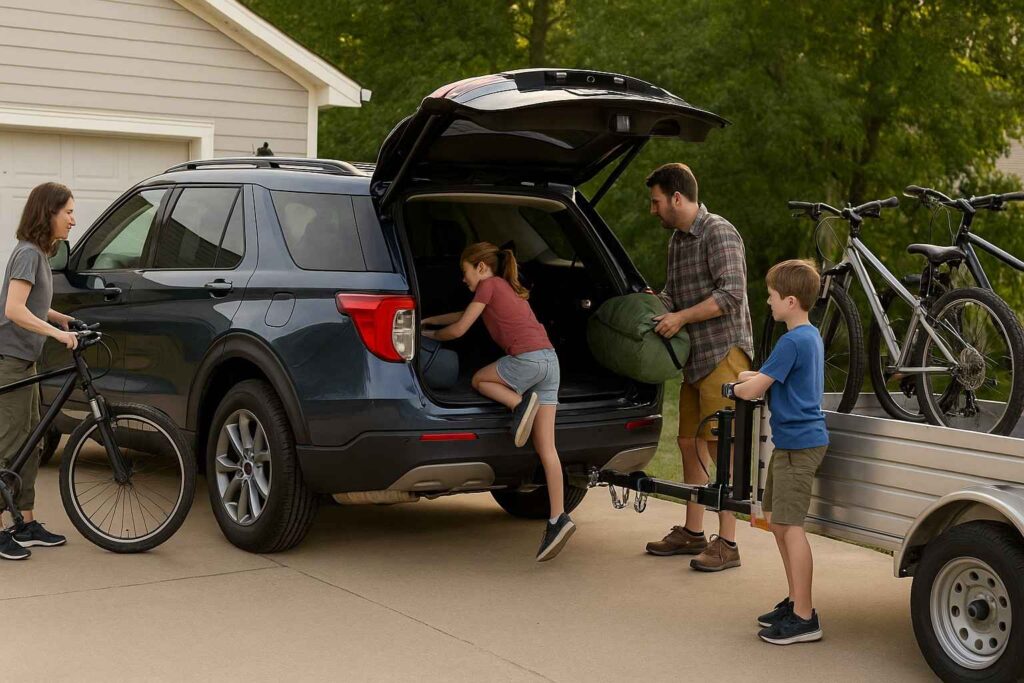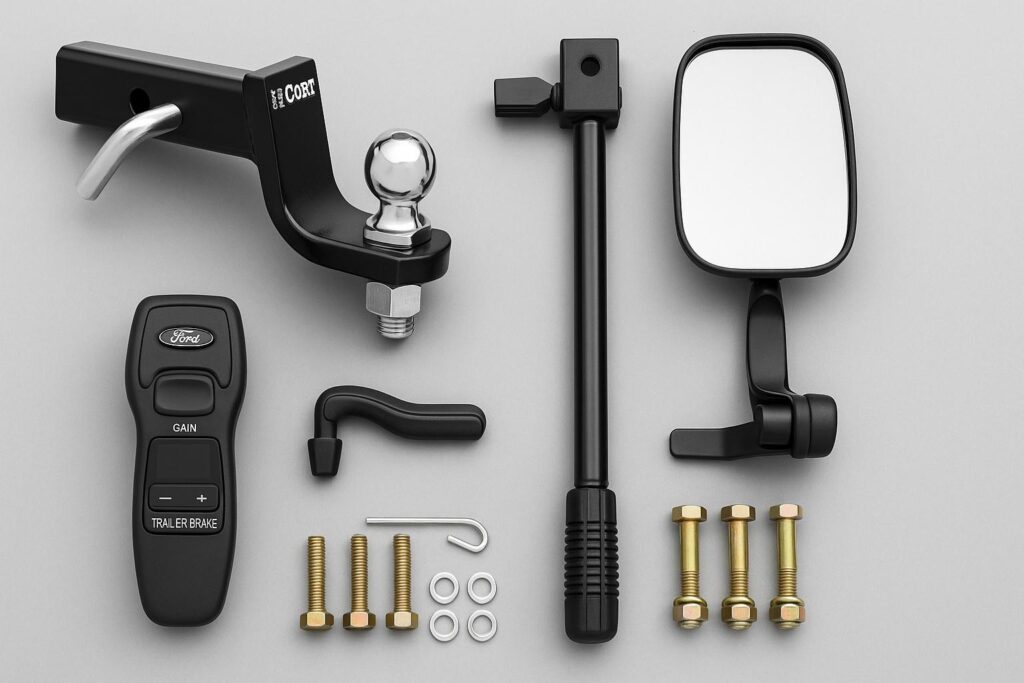Impressive 2025 Ford Explorer Towing Capacity & Complete Guide

Picture yourself heading out for a weekend getaway: kids in the back seats, gear piled in the cargo bay, and a lightweight trailer or boat hitched up to your SUV. With the 2025 Ford Explorer, you’re wondering: how much can the 2025 Ford Explorer tow? That one question drives everything when choosing a three-row family SUV that also doubles as a light-haul machine.
In this article you’ll find a full breakdown of the 2025 Ford Explorer towing capacity, what it means in real-world use (campers, boats, trailers), the required tow-package and key features, how it stacks up within its segment, plus accessories and best practices for safe towing. Let’s break it down.
Quick Overview Table
| Spec | 2025 Model Data |
| Engine & Transmission | 2.3 L EcoBoost I4 (300 hp / 310 lb-ft) • 3.0 L EcoBoost V6 (400 hp / 415 lb-ft) |
| Maximum Towing Capacity | Up to 5,000 lbs (≈ 2,268 kg) when properly equipped |
| Gross Combined Weight Rating (GCWR) | 10,000 to 10,800 lbs (≈ 4,536–4,899 kg) depending on axle and drivetrain |
| Trim Options | Active, ST-Line, Platinum, ST |
| Key Highlights | Class III Trailer Tow Package standard, seating for 6-7, modern infotainment & safety features |
| Estimated Price Range* | Starting around US$41,000 for base models (in U.S.) |
* Price estimate is global-neutral, may vary by market and options.
Engine, Drivetrain & Towing Setup

When considering the 2025 Ford Explorer’s towing capability, it’s important to understand both the engine/drive-train and the required towing equipment.
Both the 2.3-litre Eco-boost four-cylinder and the available 3.0-litre twin-turbo V6 deliver the same 5,000 lb (≈ 2,268 kg) maximum trailer-weight rating when the vehicle is properly equipped.
However, achieving that number means the vehicle has the correct rear axle ratio, the standard Class III Trailer Tow Package (now standard on all models) and proper hitch wiring and connectors.
The GCWR range of 10,000-10,800 lbs means the combined weight of vehicle, passengers, cargo and trailer must stay within that limit. That’s a subtle but critical point: you can’t simply hitch a 5,000 lb trailer if you’ve already got full load of people + gear + accessories.
Key takeaway: Engine choice doesn’t change the top tow number—what matters more is the equipment and load management.
Towing Capacity & Real-World Use

What the “Up to 5,000 lbs” Means
With a maximum trailer weight of 5,000 lbs (≈ 2,268 kg) when properly equipped, the 2025 Explorer is capable of handling many weekend-trailers, boats or campers—but with caveats.
For example:
- A smaller travel trailer or pop-up camper designed for 2–4 people often weighs 3,000–4,500 lbs when loaded. If you keep cargo light and stay within your vehicle/payload limits, the Explorer can handle it.
- Boats with trailer might weigh 2,000–3,500 lbs before gear—thus within reach. But larger boats or heavier deluxe campers will exceed capacity.
Can You Tow a Camper or Boat?
Yes—but mostly smaller or moderate ones. If your boat (with trailer) comes in at, say, 3,000 lbs and your gear adds 400–500 lbs, you’re safely within the 5,000-lb limit.
If the camper weighs 4,500 lbs but you add gear, gear for four people, etc., you’re approaching the limit and must check GCWR and payload. Overloading risks engine/transmission strain and safety issues.
Real-World Conditions to Consider
- Payload matters. If you have 6-7 passengers plus luggage, the vehicle’s own weight inside reduces your available margin for the trailer.
- Driver assists such as trailer sway control, side-wind stabilization system and tow/haul modes matter on windy roads or when towing high-profile loads. The Explorer includes these features.
- RWD vs 4WD: The GCWR differs slightly (10,000 vs 10,100 etc) depending on axle ratio & drivetrain. Always check your specific model’s label.
- Proper hitching, loading, weight distribution (tongue weight, trailer sway) and brakes on the trailer are vital. Ford’s towing guide emphasises this.
In short: The 2025 Ford Explorer does a fine job in the midsize three-row SUV class of being “good for towing,” but it’s not the heavy-haul behemoth of a full-size truck.
Tow/Haul Features, Safety & Equipment
Standard Tow Package Details
One of the standout improvements for the 2025 Explorer is that the Class III Trailer Tow Package (hitch receiver, 4-/7-pin connector, wiring harness) is now standard across the board.
Included features: trailer sway control, tow/haul mode (transmission logic adjusts for trailer load), and depending on configuration also side-wind stabilization.
Safety & Control Systems
When towing, especially with a three-row SUV pushing close to capacity, stability is more important than raw numbers. The Explorer helps with:
- AdvanceTrac with Roll Stability Control (RSC)
- Trailer Sway Control integrating with braking/engine output
- Side-wind stabilization (on select trims) that helps when gusts hit a tall trailer
- Proper wiring and connectors to ensure trailer lights, brake-lights and turn signals work reliably
Payload vs Trailer Weight — Know the Difference
It’s easy to think “my SUV can tow 5,000 lbs, so I’ll just hook up a 5,000-lb trailer,” but you must also look at how much the vehicle is already carrying (passengers + cargo). If the payload limit is say 1,500 lbs (≈ 680 kg) and you’re using 1,200 lbs for people+luggage, then you essentially reduce your margin for the trailer. The GCWR label is a helpful indicator.
What to Inspect Before Towing
- Hitch receiver rated for Class III (and correct ball size)
- Proper trailer‐brake system if required (some states/trailers > certain weight must have brakes)
- Tire pressure on vehicle and trailer (under-inflated tires are a frequent issue)
- Check that the tongue weight is correct (typically 10-15% of trailer weight)
- Use of sway bar or hitch stabilizer if trailer is tall or narrow
- Verify that the drive mode is set to Tow/Haul when needed
- Confirm the wiring connector works (all lights, brake lights, turn signals)
All of these reduce wear (engine, transmission, brakes) and increase safety.
Which Trims Support Towing & What That Means
Because the 2025 Explorer standardises the towing package and capacity across all trims, you don’t have to pick a specific “towing trim” to hit the 5,000 lb figure.
Here’s what that means in practice:
- Whether you choose the base Active, the ST-Line, the luxe Platinum or the performance-oriented ST, maximum towing capacity remains 5,000 lbs.
- The difference between trims will be in luxury, performance, drivetrain (RWD vs 4WD/AWD), suspension tuning, and off-road capability (e.g., if you tow in rugged terrain the Timberline or ST might give better clearance or more ruggedness).
- If you plan to do frequent heavy towing, you might prefer the 3.0 L V6 version for extra torque (though it doesn’t boost the top number). The extra power may help in mountain passes or with heavier loads near the limit.
Bottom line: You get towing capability across the lineup. Choose the trim based on other preferences (comfort, features, drive feel) rather than just towing.
Trade-Offs & What to Know
While the 2025 Ford Explorer offers a capable 5,000-lb towing rating, there are some trade-offs compared to larger SUVs or dedicated trucks:
Pros:
- Seats up to 6-7 people plus cargo, making it practical for families and towing.
- Modern infotainment/safety tech makes it a versatile vehicle beyond just towing.
- Standardised tow-package simplifies buying decision.
Cons: - 5,000 lb is strong for the class, but smaller than what full-size SUVs/trucks offer (which might tow 7,000-10,000+ lbs).
- With third-row seating and full gear + passengers, your actual margin for trailer weight shrinks. You may find yourself near the limit regularly.
- Fuel economy, handling and braking may degrade when towing heavy loads; you’ll need to monitor engine/transmission temps, and brake distances will increase.
If you anticipate towing large fifth-wheel campers, heavy boats (5,000–7,000 lbs+), or frequent heavy hauling, you might consider a larger SUV/truck. But for moderate towing combined with daily family use, the Explorer strikes a good balance.
Accessories & Best Practices for Towing with the 2025 Explorer

To maximise the capabilities of the 2025 Ford Explorer’s towing setup, here are recommended accessories and tips:
Accessories:
- High-quality ball mount with the correct drop/rise for your trailer.
- Weight-distribution hitch if you’re near the upper limit and need better handling (note: check Ford’s manual to see if this is allowed or recommended).
- Trailer brake controller (many states require trailer brakes above certain weights).
- Sway control bar or hitch stabiliser especially for trailers with high centre of gravity or narrow track.
- A rear-view camera or trailer-specific camera to assist when reversing/hitching.
- Spare tire for trailer + vehicle, and proper towing mirrors if boat/large trailer blocks view.
Best Practices: - Always check your vehicle’s placard (driver-door jamb) for exact payload, GVWR and GCWR for your specific VIN.
- Confirm trailer gross weight, cargo in trailer, and that tongue weight falls within 10-15% of trailer gross weight.
- Before departure: check tire pressures, lights, wiring connectors, hitch security, load distribution.
- On long climbs, heavy loads or hot ambient temps, monitor engine/transmission temps and consider giving yourself extra braking distance downhill.
- Use Tow/Haul mode when towing (changes shift logic, down-shifts earlier, holds lower gear longer).
- Avoid overloading, and if you frequently tow near the maximum, adopt a preventive maintenance schedule (fluids, cooling system, brakes, tires) more aggressive than for non-towing use.
These steps help ensure you’re towing safely, preserving vehicle longevity and enjoying the adventure.
Segment Comparison: How Does It Stack Up?
Within the midsize three-row SUV segment, the 2025 Explorer holds its own in towing capability. Here’s a quick comparison:
- Versus rivals like the Honda Pilot or Kia Telluride, which may have towing ratings in the 4,000-5,000 lb range, the Explorer’s standard 5,000 lb is a strong point.
- That said, large full-size SUVs and trucks (e.g., Ford Expedition) offer much higher tow ratings if your need is heavier.
If you value three-row space, technology, daily usability and respect that you’re hauling moderate loads (not the heaviest trailers), the Explorer is a balanced choice.
Conclusion
The 2025 Ford Explorer stands out as a reliable and versatile three-row SUV that doesn’t compromise when you need to tow. With a maximum towing capacity of up to 5,000 lbs, a standard Class III Trailer Tow Package across all trims and strong safety/towing-control aids, it strikes a smart balance between family usability and hauling ability. While it isn’t designed for the ultra-heavy trailer work of full-size trucks, for most boating, light camping and gear-hauling duties it offers more than enough. If you properly equip the Explorer, manage your loads wisely and follow towing best practices, you’ll have a vehicle that’s both comfortable for daily use and competent when adventure calls.
Discover expert car tips, towing guides, and vehicle insights at CarFact.online.
FAQs : 2025 Ford Explorer Towing Capacity & Complete Guide
Q: What is the towing capacity of the 2025 Ford Explorer?
A: When properly equipped with the standard Class III Trailer Tow Package, the 2025 Ford Explorer has a maximum trailer towing capacity of up to 5,000 lbs (≈ 2,268 kg).
Q: Can a 2025 Ford Explorer tow a camper or boat?
A: Yes — provided the combined weight of the trailer (or boat + trailer) falls within the 5,000 lb limit and that your vehicle’s payload and GCWR limits are respected. For heavier or larger trailers, you may hit the limit.
Q: Does the 2025 Ford Explorer come with a tow package?
A: Yes — the Class III Trailer Tow Package (including hitch receiver, wiring harness, etc.) is standard across all 2025 Explorer models.
Q: Which trims of the 2025 Ford Explorer support towing?
A: All trims — Active, ST-Line, Platinum and ST — support towing up to 5,000 lbs when properly equipped; the tow-capability is standardised across the range.
Q: Is the 2025 Ford Explorer good for towing heavy loads?
A: It is very capable for moderate-weight trailers and typical family-adventure loads. However, if by “heavy loads” you mean 6,000–7,000 lbs+ trailers or frequent use at max capacity, a larger SUV or truck may be a better fit. Always consider your full load scenario including passenger + cargo + trailer.
Have questions about the 2025 Ford Explorer Towing Capacity? Contact us—we’re here to help you find the right answers.
